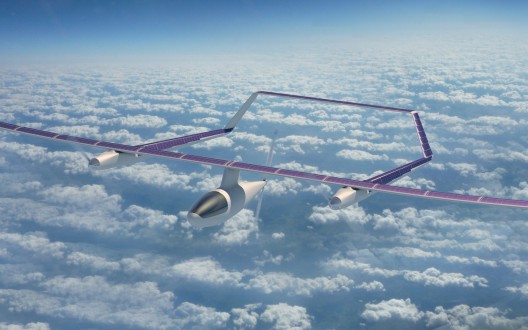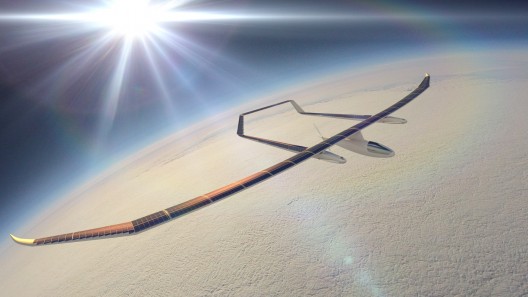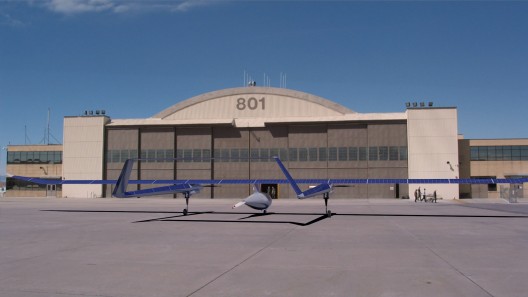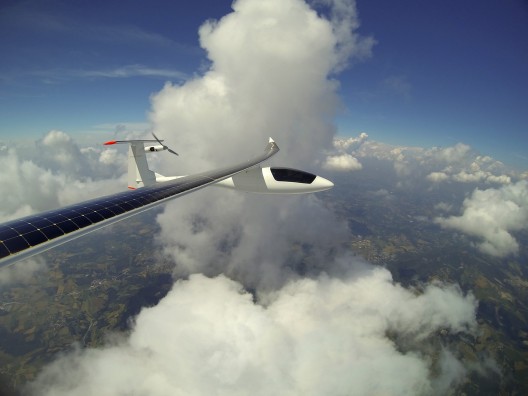Eric Raymond has been designing and building solar-powered aircraft for 28 years, and flew Sunseeker 1 across the United State in 1990, Sunseeker 2 over the Alps in 2009, and has started touring Italy in the world’s first two-seat sun-powered aircraft, the Duo. After three such outstanding efforts, what direction will his new design take?
He took away any mystery on that today by unveiling his fourth aircraft, an optionally manned, high altitude platform, SUNSTAR. Eric claims, “more performance potential than any of the other projects now under development.
“Compared to other solar UAVs (unmanned aerial vehicles) being developed, the Sunstar promises higher flight speeds in a turbulence-tolerant design, for operation in real world conditions.”
“Sunstar takes advantage of sailplane aerodynamic design philosophy to achieve the lowest possible power requirement to maintain flight at high altitudes.” It takes technology tested on the Sunseeker Duo “to a whole new level.”

Having reached station altitude, the central, pusher propeller can deploy. Its slow turning will use minimum power for greatest endurance. Illustration courtesy Solar-Flight
Capable of unmanned flight for months at a time, the airplane can also fly with a pilot for shorter missions, but its primary mission is as an unmanned telecommunications platform, staying on station longer than humanly tolerable. Eric Raymond adds this perspective, “”What we are designing is known as an atmospheric satellite, which operates and performs many of the functions as a satellite would do in space, but does it in the atmosphere. Uplink and downlink speeds will be far better than a satellite, due to the shorter distance (than from a space satellite).” At the same time, one Sunstar aircraft serves a much larger ground area than any land-based tower.
The airplane, now in advanced design stage, will have the best coverage of solar cells ever achieved, according to Solar-Flight. “A proprietary lamination of a new type of solar cell forms a perfectly smooth skin. For maximum power at low sun angles some solar arrays are mounted on the sides of the aircraft.”

With pusher propeller holding altitude on minimum power, “climb” propellers fold neatly onto sides of nacelles for minimum drag. Illustration courtesy Solar-Flight
The three-motor configuration allows the airplane to take off on the front motors, climb to altitude, and deploy the very large pusher propeller at the rear of the cargo/pilot pod. Once that propeller, optimized for high altitude, holds the airplane’s station altitude, the two motors on the booms shut down and their propellers fold back to minimize drag. Solar-Flight adds, “This central motor is designed for the low power cruise condition, for minimal power consumption while on station.
In an email, Eric explains, “There are good reasons for this configuration. If you remember, when the Voyager flew around the world, they shut off an engine for more efficient cruising. In this case, the very large prop needed for high altitudes can’t get enough ground clearance, so take off is performed with that prop folded back, as per the attached renderings.”

Sunstar showing folded rear propeller which can only be opened when the airplane is at altitude. Illustration courtesy Solar-Flight
Eric shares his long-term hopes for the project. “…We will not start construction until enough funding is in place to finish the prototype. Our business plan details two years to first flight, and production examples could be flying a year after that. A lot depends on payload requirements.”
Sunstar’s design relies on a modular system configurable for a variety of missions. The interchangeable central pod can acts as a multi seat cockpit, or an un-manned instrument pod. “A pressurized cockpit for the occupants is also in the planning stage. The wingspan can be changed for different missions, by eliminating some wing sections. “
To be flown initially with a pilot on board, then optionally manned, the airplane will eventually achieve fully autonomous operation, subject to the governing country’s regulations. “The inclusion of a manned cockpit in the prototype allows much more freedom in testing, considering the restrictions placed on un-manned aircraft over populated areas.” From the beginning, all controls will be “fly-by-wire,” probably necessary because of the long span and the ability to add and remove wing panels for different missions. Prototypes of SUNSTAR’s systems are already flying in Solar Flight’s flagship, the Sunseeker Duo.

All systems to be used on Sunstar have been tested on the Sunseeker Duo. Photo courtesy Solar-Flight
Eric hopes to attract strategic partners, who would be able “to help define mission-specific optimization and bring the project to completion.” Eric invites those with an interest in developing this project to “Visit our web site for in flight video footage of our current state-of-the-art solar powered airplanes.”

Comments 2
Hi Eric and team. I’ve been thinking about something and I’m not sure whether it has been tried yet…has helium been considered yet(I’m sure it has) as an assistant sustainer of sorts? Bladders in the wings or spare spaces and regulated helium fills and assists with buoyancy…?
Ok, it was thought of 40 years ago? 😉
Cheers,
Andrew
Hi Eric,
Great concept, it appears to be extremely competative with satellites on a specific performance basis.
I can probably help with finding interested partners… What do you think it will take to get to a proof of principle demonstration flight/series (dollars & time)?
Roy
Cell: 951 323 9797